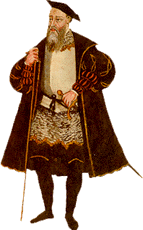Famous Navigators
A tribute to the great Portuguese navigators
Vasco da Gama
Vasco da Gama like most others in Europe knew that Christopher Columbus had not reached India. He was convinced that the only way to reach India was to sail around Africa, a route that Bartholomeu Dias had shown to be feasible.
In July 1497, a fleet set sail from Lisbon, Portugal under the leadership of Captain Major Vasco da Gama to find a sea route to the fabled land of India. The crew consisted of about one hundred and fifty men. The first landing was on November 4, at a place they called Santa Helena bay. On November 22, they rounded the Cape of Good Hope and the next stop was Mossel Bay, where Bartholomeu Dias had landed ten years before. They then sailed further north and landed at Malindi and on April 24, they set out from Malindi to cross the Indian Ocean. On May 20, 1498 they anchored a few miles off Calicut, India, which had been the principal market for trade in spices, precious stones and pearls from the fourteenth century. Vasco da Gama's voyage had taken almost a year, but he actually accomplished what Christopher Columbus had set out to do!
In October 1498, the fleet began its homeward voyage. Vasco da Gama reached Lisbon in September, where a brilliant reception awaited him. He was appointed to the newly created post of Admiral of the Indian Ocean, which carried a high salary, and feudal rights over Sines were assured to him. In 1502 Gama, was again sent to India and returned with merchandise amounting to more than a million in gold.

Sea Route to India
In 1524, he was sent under the Crown Joao III to India. On December 24, of the same year, Vasco da Gama died in Cochin, India. In 1539, his remains were brought back to Portugal and interred at Vidigueira, where they were kept for three centuries. In 1880, together with the remains of the Poet Luis de Camoes, they were moved to the Monastery of Jeronimos. Considered the highest representatives of the Portuguese Discoveries, Vasco da Gama (on the left hand side) and Luis de Camoes (on the right) were given the privilege to rest side by side with kings.